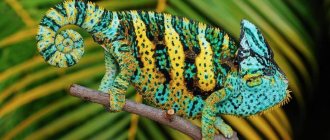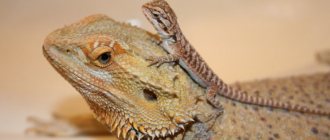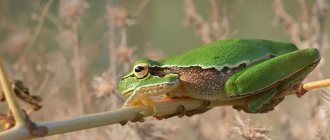Proper feeding of pet reptiles is a very important aspect of being a responsible owner. Some reptiles are like children, which means they choose foods that they like, and not necessarily those that are good for them. The green iguana is notorious for being a picky eater.
The green iguana should be fed a completely vegetarian diet of approximately 95% vegetables and 5% fruits, prepared in such a way that even a picky iguana cannot eat only the foods it likes. You can also offer small amounts of commercially prepared iguana diet.
Frustrated iguana owners often complain that they can't get their pets to eat more than one or two of their favorite foods. If your iguana is in this group, don't despair. There are several simple ways to transition your lizard to a more balanced diet.
Say no to fancy snacks
Iguanas are herbivores, or animals that naturally consume a diet consisting entirely of plant material. Specifically, they are folivores (they eat foliage). While a pet iguana may develop unusual food choices (hot dogs, cat food, and jelly beans come to mind), it should only be fed vegetables and fruits, even if it seems to relish other foods.
Iguanas should not be fed prepared food for other animals. The bulk of the diet, approximately 95 percent, should consist of vegetables, mostly dark green, leafy vegetables rich in calcium.
What do iguanas eat in the wild?
The iguana family has 38 species, each of which is unique. The diet of the animal depends on the genus, species, way of life and habitat. Some eat only grassy foods, others are predators, and some can feast on both meat and grass.
The most numerous genus is the “ black iguana ”; it has up to 18 species. These individuals feed mainly on plant foods, sometimes insects.
The most common species is the green iguana . These animals feed exclusively on plants. Their diet includes leaves, grass, berries, some fruits, as well as young tree branches.
On a note! Most carnivorous iguanas are small in size and distributed in the southern United States.
Greenery
Recommended greens include kale, mustard greens, turnip tops and greens, bok choy, pak choy, broccoli rabe or rapina (the leaves, not the flowers, from the broccoli plant), clover and dandelions. Swiss chard, beet greens, escarole, parsley and watercress are also good choices. Lettuce tends to be low in minerals, although romaine is more nutritious than other types. The outer, darker leaves have a higher mineral content than the inner, lighter leaves, so always try to feed the outer leaves. Spinach has been implicated in the formation of calcium oxalate stones, and for this reason some iguana keepers avoid this green color. However, some iguana owners offer small amounts with no problem. If you choose to offer spinach, do so in small quantities.
Green iguana - rules for home maintenance and care
The green iguana has long been one of the most popular pet lizards in the United States. In recent years, this exotic reptile has increasingly become a pet on our continent. The animal is a herbivore and leads an arboreal lifestyle. Growing to an impressive size, such a lizard requires a huge terrarium and a lot of attention.
Flowers
Flowers such as roses, nasturtiums, carnations and hibiscus are excellent; however, beware of artificial flowers and chemicals that may be found in floral arrangements. Nutritious vegetables include: radish, clover, bean sprouts, peppers (red, yellow and green), pumpkin, carrots, fresh corn, green beans, pea pods, okra, cooked sweet potatoes, chopped parsnips, Brussels sprouts, cauliflower, cucumber and mixed, defrosted, frozen vegetables. You can also feed your iguana prickly pear cactus pads (without the spines or bristles) as well as soaked alfalfa pellets. Although the reason is unclear, iguanas tend to prefer red and orange foods.
What not to give
The health and well-being of the iguana depends entirely on its diet. In nature, animals feed on young leaves of flowers and fruits. A characteristic feature of the iguana's gastrointestinal tract is that it cannot digest animal protein. The digestive tract of lizards contains enzymes that can only break down plant foods.
What is not recommended to give to an iguana:
- Cold food from the refrigerator.
- Vegetation collected near highways and other industrial production.
- Stale fruits, vegetables.
Knowing what iguanas eat in the wild and what they can be fed at home, a novice breeder will be able to organize proper nutrition for his pet. In addition, it is worth remembering that the iguana must warm up before eating, otherwise problems with the digestive system may occur.
Fruits fortified with calcium
Fruits high in calcium should make up the remaining 5 percent of the diet. The best fruits to offer include:
- Grape
- Papaya
- Mango
- Raspberries
- Figs
Other fruits that may sometimes be offered include:
- Apples
- Plums
- Peaches
- Blueberry
- Melons
- Pears
- Cranberry
- Tomatoes
- Kiwi
- Guavas
- Strawberry
- Bananas
Lighting
In the wild, iguanas spend much of their time basking in the sun. Sunlight is necessary for the production of vitamin D, which iguanas require in the same way as humans to produce calcium in their bodies. Therefore, UV lamps can become an analogue of sunlight. However, your iguana also needs a few hours a week of natural sunlight, if possible. Using a lamp timer, you can give your pet a 12-hour day and a 12-hour night.
Food warning
Why can't an iguana eat monkey biscuits, or a dog, or a cat? There's a good chance the cookies are high in vitamin D3, which can be extremely harmful to iguanas. This vitamin in high levels can cause the development of dangerous calcium deposits in the iguana's internal organs (called mineralization), which impair function and can lead to death.
Dog and cat food typically contains animal proteins and fats, as well as high levels of nutrients, including some vitamins that iguanas should not consume. Over time, the nutrients in dog and cat food can also damage internal organs. Although your iguana may find these foods tasty, they are best avoided in the diet.
How to keep food fresh
To provide fresh food to iguanas, it is either home grown or frozen.
Some types of greens can be grown directly on the windowsill. In the summer, you can get vegetables, herbs, and fruits from your garden plot. Fresh herbs will keep in a dry container in the refrigerator for about a week.
During the cold season, pet food will have to be frozen. Before doing this, you first need to wash the food, pour boiling water over it and dry it well. To serve frozen food to your pet, it must be heated. To avoid health problems, your reptile should never be offered cold food.
During the cold season, pet food will have to be frozen.
It is not recommended to feed animals only frozen food. This can lead to a deficiency of B vitamins.
Water intake
Most iguanas get most of the water they need through their food, so make sure you provide fresh, succulent food regularly. Iguanas cannot drink water from a bowl, but it must be provided nonetheless. Iguanas should be placed in a large container of warm water several times a week to allow swimming, drinking, and exercise (it is normal for iguanas to defecate during exercise). Do not allow your iguana to swim in a bathtub used by people if possible. If necessary, disinfect it thoroughly after your iguana takes a bath.
Iguana diseases
If you create and maintain the right conditions for common iguanas, they will not get sick. If you suspect any disease, call our store and we will advise you.
What health difficulties may you encounter:
- Calcium deficiency: leads to curvature of the spine and deformation of the limbs, so it is very important to give vitamin and mineral supplements with each feeding. Ultraviolet lamps must be replaced within the specified periods; the service life of such lamps is approximately one year. Our website has a convenient service for reminding you to replace lamps, with which you don’t have to remember the installation dates of the equipment.
- Digestive problems: give only fresh, proven products, do not experiment with unknown greens, remove uneaten food before it has time to spoil and the iguana decides to feast on it. Let the animal fully warm up after eating and digest it calmly.
- Dehydration: Bathe your iguana up to several times a week, especially young ones, and make sure to maintain humidity in the terrarium.
- Skin problems: poor shedding and fungus. If there is insufficient humidity in the terrarium, the iguana will not shed well. The remaining pieces of shedding on the body, tail or fingers must be removed by first soaking them in water. Fungus can occur due to poor ventilation in the terrarium, so choose only terrariums with a proven ventilation system.
If you notice strange spots on your body, contact our specialists in the veterinary chat in the app, and we will help you create a treatment plan.
- Diseases caused by improper diet: gout, metabolic disorders, kidney failure, kidney stones. It is important not to feed the iguana food that is not intended for it, many recommend feeding young iguanas with insects or animal protein, they gain weight faster this way, but this is harmful and unnatural for them and will simply kill them by the age of 4-5 years.
- The iguana sneezes: the iguana removes excess salts in the body by sneezing, this is a normal phenomenon, since herbivorous lizards have special glands with which they get rid of excess salts in the body, while maintaining the necessary moisture.
Correct temperature
In order to properly digest nutrients, the iguana must be kept within a certain temperature range. During the day, the cage temperature should be between 85 and 90 degrees F, with a basking hot spot maintained between 95 and 100 F. At night, the cage temperature should not drop below 70 F. It is best to place several digital thermometers throughout cage to control temperature.
The reservoir must also be damp. One way to do this is to spray it with a fine mist of water two to three times a day.
It may take persistence and a keen eye to ensure your iguana consumes healthy food. They can be picky and strong-willed, but with your guidance they can see that the proposed diet is actually eaten. Because young iguanas grow quickly, proper nutrition is vital to their health.
Rules and regulations of feeding
Iguanas have a fairly sensitive digestive system. When feeding, you should follow certain rules:
- The pet should be fed daily. Adults are fed once a day, and young ones - 2-3 times.
- For normal intestinal activity, the reptile must warm up before and after eating. The temperature in the terrarium should be 38-40°C.
- The iguana should be fed at the same time every day. After eating, the lizard should have several hours left before sleep (during sleep, the temperature in the terrarium should be reduced, and at low temperatures the iguana’s metabolism slows down, the intestinal tract does not digest food, which leads to problems with the digestive system).
- The reptile's diet should be varied. It is recommended to offer at least 10 varieties of food per meal. But it is worth taking into account that iguanas prefer consistency in the menu. You need to be prepared for the fact that it will take a lot of patience to introduce a new product into your diet.
- The lizard must get enough calcium from its diet. She needs it for the development of the skeleton, claws, and teeth. In order for calcium to be properly absorbed, you need vitamin D. An ultraviolet lamp promotes the production of this vitamin. Also, the presence of a lamp increases the pet’s appetite.
- Young animals need protein, which should make up 15-20% of the total diet. Protein is found in dandelions, honey, alfalfa sprouts, and mustard. But it is worth considering that its excess leads to kidney failure.
- Dehydration is dangerous for your reptile. It is important that there is always a bowl of clean water in the terrarium.
- Food should be finely chopped or grated.
- You should not give your iguana food from the table. The reptile is very inquisitive and will strive to try everything that its owner offers it. Tamed lizards do not see the plant world before their eyes and therefore taste everything. This is often done by young reptiles.
Interesting fact! Baby iguanas eat the feces of their parents. It is believed that by doing this they populate the microflora in the intestines, which will help complete digestion.
Decreased appetite in iguanas does not always indicate problems in the body. It can be observed, for example, at low temperatures in the terrarium. Loss of appetite is also observed during molting, when adapting to a new place, and during pregnancy in females.
It is best to feed the iguana from 12 to 15 hours. By this time, the body has already woken up, the digestive system will warm up and be ready for work. There is still a lot of time before going to bed and the food will have time to be completely absorbed.
It is better to reschedule later feeding (after 15:00) to the next day. Hunger is not as bad for iguanas as eating late. This can lead to impaired metabolism and cause diseases.
Creating a terrarium
This area should resemble the natural habitat of the lizard. Be sure to take into account:
- size and volume;
- humidity;
- temperature.
And of course, you should know how to properly arrange a “living area”. The owner will be able to periodically take out a rare representative of tropical fauna from there, bathe it, walk it at home and even in the yard, and communicate with it as much as possible. However, we must not forget that the domestic iguana should soon find itself back on its territory - in a cozy terrarium.
Normal humidity and temperature are created there, and a long stay in ordinary room conditions can be disastrous for a tropical guest.
Habitat
The green iguana is one of the most widespread species of lizard, its original range spans the tropical regions of the Western Hemisphere from southern Mexico south to central Brazil, Paraguay and Bolivia, east to the Lesser Antilles.
In the second half of the 20th century, lizards were introduced to Grand Cayman, Puerto Rico, the Virgin Islands, the mainland states of Florida and Texas, and Hawaii. They spend most of their lives on trees, usually growing along the banks of slow-flowing rivers. Iguanas are active only during daylight hours. They spend cool nights on thick branches in the middle and lower tier of trees, but with sunrise they try to climb higher, where they bask for a long time - sunbathing raises body temperature, and ultraviolet radiation produces vitamin D, which promotes digestion.
Reproduction
During the mating season, which lasts about two weeks, males choose a future mating site, mark the territory using secretions from pores in the lower parts of the limbs, and become aggressive towards nearby rivals. In nature, direct clashes between them are quite rare; in the event of a threat, the weaker lizard in the event of a conflict prefers to leave someone else's territory rather than engage in a fight.
The demonstrative behavior of the male is frequent shaking of the head, inflating the throat sac and changing the color of the body to a brighter, more saturated one. Pregnancy lasts about 65 days. At its end, the females leave their traditional habitats along the river banks, and along the beds of the streams flowing into them, they go upstream to dry sandbanks and dunes.
Incubation lasts from 90 to 120 days. The cubs are usually born in May, breaking through the shell with the help of a special fleshy growth on the forehead and climbing to the surface of the earth. They are almost identical in color and shape to adult individuals, but have only a weakly defined crest. Young lizards are quite independent, although when they are born they may have a small yolk sac containing a nutritional mixture for the first one to two weeks.
Origin of the species and description
Photo: Iguana
This species was first formally described by the Swedish botanist Carl Linnaeus in 1758. Over the two centuries since then, many subspecies have been identified, but later, after genetic studies, they were classified as simple regional variants of the same species, except for the Caribbean iguana.
Video: Iguana
Using nuclear and mitochondrial DNA sequence data to study the phylogenetic history of the iguana, the scientists studied animals collected from 17 different countries. Topology of the phylogeny showed that the species originated in South America and eventually moved through Central America and the Caribbean. The study did not identify unique mitochondrial DNA haplotypes for subspecies status, but indicated deep lineage divergence between Central and South American populations.
There are two subspecies of the common iguana:
- iguana iguana iguana is distributed in the Lesser Antilles and South America;
- iguana iguana rhinolopha - This form is native primarily to Central America.
Both taxa can be fairly safely distinguished by the two or three small “horns” present on the face of iguana rhinolopha. The word "iguana" comes from the Spanish form of the name in the language of the Taíno people, who lived in the Caribbean before the arrival of the conquistadors and sounded like "iwana". Over time, the Spanish version of the name became the scientific name of this species. In some Spanish-speaking countries, males of the species are called gorrobo or ministero, while juveniles are called iguanita or gorrobito.











